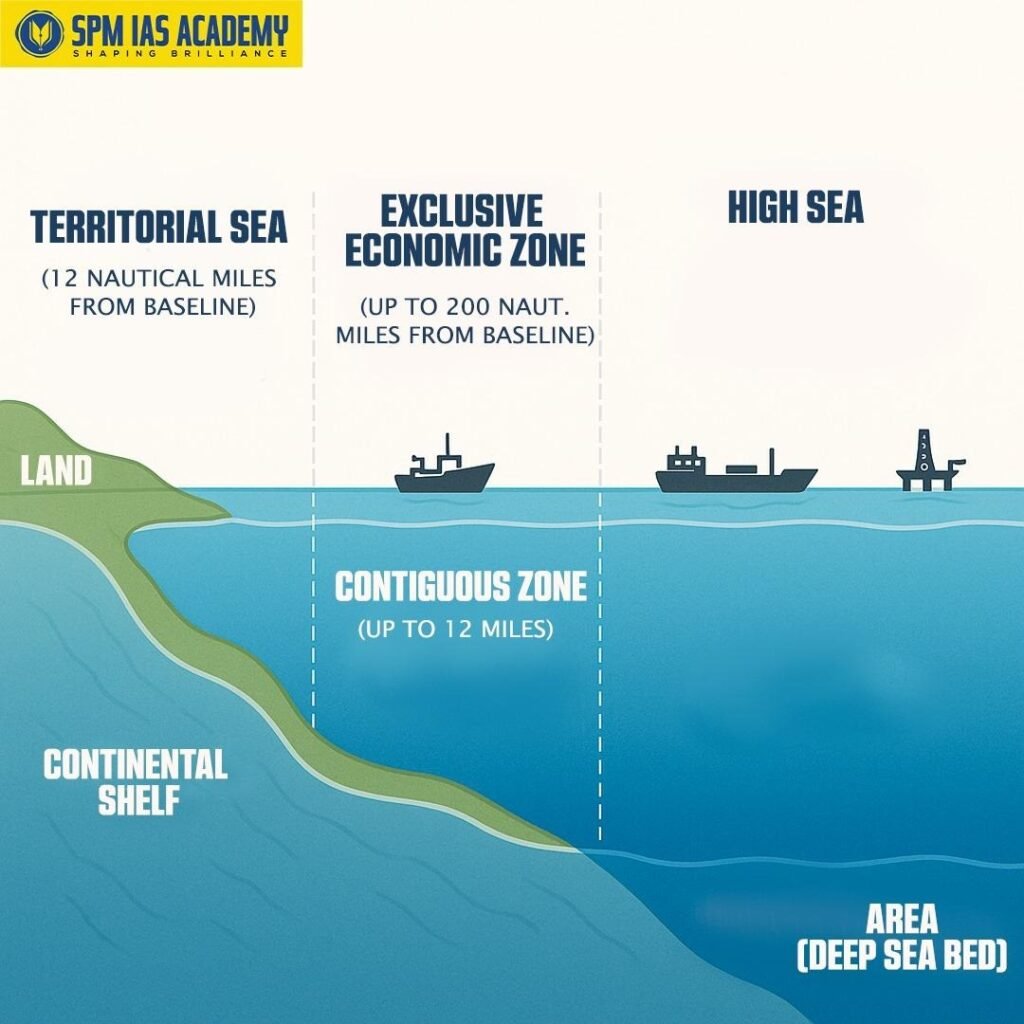A Landmark Step Toward Global Ocean Governance and Biodiversity Conservation
Why in the News?
- In 2023, after nearly two decades of negotiations, United Nations member states adopted the High Seas Treaty, formally known as the ‘Biodiversity Beyond National Jurisdiction (BBNJ)’ Agreement.
- The treaty aims to protect marine biodiversity in areas beyond national jurisdiction, commonly referred to as the high seas. High seas cover over two-thirds of the world’s oceans.
- As of October, 2025, around 61 countries ratified the treaty. It will enter into force in January, 2026.
- Morocco and Sierra Leone joined the list of States as the 60th and 61st parties to the pact.
- Secretary-General António Guterres welcomed the development, calling it a “historic achievement for the ocean and for multilateralism.”
For aspirants and readers following environmental diplomacy, keeping track of recent current affairs updates helps understand how global treaties like the High Seas Treaty align with major international developments and sustainable development goals.
Background: Understanding the High Seas
- The high seas are ocean areas that lie beyond 200 nautical miles from a country’s coastline and fall outside national jurisdictions.

- These waters are governed by the principle of the “freedom of the seas”, which allows navigation, fishing, and scientific research by all nations — but without a dedicated global conservation framework until now.
- The United Nations Convention on the Law of the Sea (UNCLOS) of 1982 regulates maritime rights and responsibilities.
- But it did not specifically address biodiversity protection beyond national boundaries.
- Hence, there is a need for the Biodiversity Beyond National Jurisdiction Agreement (BBNJ).
About the Treaty:
- Adopted by the UN Member States in June, 2023 after nearly two decades of negotiations.
- The pact – also called the “high seas treaty” – covers two-thirds of the world’s ocean area that lies beyond national boundaries.
- It establishes legally binding rules to conserve and sustainably use marine biodiversity, share benefits from marine genetic resources more fairly, create protected areas, and strengthen scientific cooperation and capacity building.
- It will provide a global framework to help achieve international biodiversity targets, including the pledge to protect 30 per cent of land and sea areas by 2030 under the Kunming-Montreal Global Biodiversity Framework.
Evolution of the Treaty:
- The treaty’s development was two decades in the making.
- In 2004, the UN General Assembly established an ad hoc working group to address gaps in UNCLOS, which lacked specific provisions on biodiversity beyond national jurisdiction.
- By 2011, states had agreed to negotiate four key areas: MGRs, ABMTs, EIAs, and capacity building.
- Between 2018 and 2023, four Intergovernmental Conferences were held, culminating in an agreement in March 2023.
- The treaty was formally adopted in June 2023, setting the stage for a new era of cooperative ocean governance.
Key Objectives of the High Seas Treaty:
- Conserve and Sustainably Use Marine Biological Diversity beyond national jurisdictions.
- Create Marine Protected Areas (MPAs) in the high seas.
- Regulate the sharing of marine genetic resources (MGRs) and ensure equitable benefit distribution.
- Establish Environmental Impact Assessment (EIA) mechanisms for deep-sea activities.
- Facilitate Capacity Building and Technology Transfer for developing nations.
Major Provisions of the High Seas Treaty:
- Marine Genetic Resources (MGRs)
- Addresses ownership and sharing of benefits from genetic materials found in deep-sea species.
- Ensures that developing nations get a fair and equitable benefit share from MGR-based products (like pharmaceuticals and cosmetics).
- Marine Protected Areas (MPAs):
- Enables the creation of sanctuaries to safeguard vulnerable ecosystems such as coral reefs and hydrothermal vents.
- Targets the UN goal of protecting 30% of the world’s oceans by 2030 (30×30 target).
- Environmental Impact Assessments (EIAs)
- Makes it mandatory for all high-sea activities to undergo strict environmental assessments before approval.
- Capacity Building and Technology Transfer
- Promotes equitable sharing of marine technologies and training for developing countries.
- Institutional Mechanisms
- A Conference of Parties (COP) will oversee the implementation.
- A Clearing House Mechanism will ensure transparency in data sharing.
Significance of the High Seas Treaty:
| Aspect | Significance |
| Marine Conservation | Protects ocean ecosystems crucial for climate regulation and biodiversity. |
| Global Equity | Ensures fair access to marine resources and equitable benefit sharing with the developing countries. |
| Scientific Advancement | Encourages research while ensuring environmental safeguards. |
| Governance Gap Filler | Complements UNCLOS by providing a legal framework for biodiversity beyond borders. |
| Climate Action Support | Oceans absorb 25% of CO₂ emissions; protecting them supports climate goals. |
Why is the High Seas Treaty critical for the world?
- Protection Beyond Borders: Ensures global stewardship of oceans for present and future generations; safeguards marine ecosystems and biodiversity under the UN Convention on the Law of the Sea.
- Cleaner Oceans: Tackles marine litter — over 17 million metric tons of plastic entered oceans in 2021. Enforces the ‘polluter-pays’ principle and mandates environmental impact assessments for activities beyond national borders.
- Sustainable Fish Management: Addresses over-exploitation of one-third of global fish stocks. Promotes capacity building, technology transfer, and collaboration among regional fisheries and marine organizations.
- Combating Climate Change: Encourages ecosystem-based ocean management to build resilience against climate change and ocean acidification while supporting carbon cycling.
- Supporting the 2030 Agenda: Essential for achieving SDG 14 — reducing marine pollution, ending overfishing, and restoring fish stocks through science-based management by 2025.
Understanding seasonal cycles in India provides context for how climate patterns influence marine ecosystems and biodiversity — a critical aspect when assessing the environmental and ecological impacts highlighted in the High Seas Treaty.
Challenges Ahead:
While hailed as a major breakthrough under the United Nations Convention on the Law of the Sea (UNCLOS, 1982), the treaty faces significant implementation challenges, ranging from definitional ambiguities to geopolitical resistance by major powers.
- Ensuring universal ratification and enforcement.
- Balancing economic interests (fishing, mining) with conservation.
- Funding marine protection for developing countries.
- Monitoring and compliance in vast ocean spaces.
Prelims Practice Question:
The High Seas Treaty, often mentioned in the news, is associated with:
(a) Regulating nuclear weapons testing
(b) Conservation of marine biodiversity beyond national jurisdiction
(c) Protecting ocean ecosystems outside national boundaries
(d) Preventing illegal human migration via sea routes
Correct Answer – (c) Protecting ocean ecosystems outside national boundaries
Conclusion:
The High Seas Treaty represents a historic achievement for multilateral environmental diplomacy, uniting the world to protect one of the planet’s last global commons — the ocean. By balancing conservation, equity, and sustainable use, it sets the stage for a more inclusive and resilient global marine governance framework. As we confront the triple planetary crisis of climate change, biodiversity loss, and pollution, this agreement is a lifeline for the ocean and humanity.
Sources:
- Beyond borders: Why new ‘high seas’ treaty is critical for the world
- What are the challenges with the High Seas Treaty? | Explained
FAQs:
The High Seas Treaty, or Biodiversity Beyond National Jurisdiction (BBNJ) Agreement, is a UN pact adopted in 2023 to protect marine biodiversity in international waters. It ensures conservation, sustainable use, and fair benefit-sharing of ocean resources beyond national boundaries.
As of October 2025, 61 countries — including Morocco and Sierra Leone — have ratified the treaty. It will officially enter into force in January 2026 once the required ratifications are complete.
The treaty aims to:
Create Marine Protected Areas (MPAs) in international waters.
Regulate and share benefits from marine genetic resources (MGRs).
Enforce Environmental Impact Assessments (EIAs) for deep-sea activities.
Support capacity building and technology transfer for developing nations.
By promoting ecosystem-based ocean management, the treaty enhances ocean resilience, reduces climate-related damage, and helps maintain the carbon cycling capacity of marine ecosystems — vital for lowering global temperatures.
The treaty directly supports SDG 14 – Life Below Water, aiming to reduce marine pollution, end overfishing, and protect 30% of the ocean by 2030 under the Kunming-Montreal Global Biodiversity Framework.












